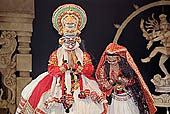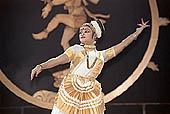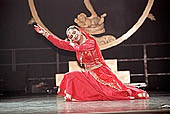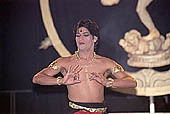| enter keyword to search: |
|
Images db
|
|
|
Articles db
|
|
|
|
|
|
|
| The rhythm of God: the dance in the religions of India |
|
Except that in ancient pagan rites, in the Dionysian cults of ancient Greece, and in some explosions of exultation in the Jewish world, the dance, in the western culture, had never a religious statute, like in the tradition of Indian religions. Believed to be directly inspired by the god Brahma, dance theory is coded in that big set of precepts on theatrical dance, writing, music, mimicry and feelings, called the fifth Veda. Such reverence for dance, for its divine fervour, mysticism, was not seen in other civilizations.

|
India Classical Dance
|
Indian culture has always conceived its gods as dancers and dance was an essential attribute of gods. The Shaivite tradition perceives the origin of dance in Shiva. Shiva and his variously named consort performed dance in all their manifestations. The tradition reveres Shiva as Nataraja - the king of dance. 'Tandava' was his dance danced in absolute bliss over the dissolution. He danced and in the beats of his drum and moves of his feet re-cast unruly skies and sounds, violent waters and cosmic disorder were set to discipline, to ordered movement. In Indian tradition dance has a divine dimension and in early days it was a temple-related activity, and was performed outside the temple only on rare occasions. From around the eighth century, temples began having regular dancers for dance-rituals 'devadasis' the temple dancers. The other dancers, kept in harem to serve the king, where kwon as 'rajadasis'.
Indian Classical Dance |

|
Unlike other arts, the dance was an unearthly thing, being the sole dialogue between the individual soul and the Supreme Soul. The dancer sublimated his own self, body and soul and united with the supreme Self. Rasa the emotional states that the audience experiences constitutes the peak of the dance. Through the exactness of their gestures, their knowledge of the movements of the body, of the music, of the texts that put in scene the devadasis, sacred dancers put the spectator in contact with the divine Self .
Elaborated gestures of hands and movements are classified and coded in precepts, as graceful 'lalita' and more vigorous 'tandava'. The pupils and the eyelids are trained to accomplish 9 movements, the eyebrows 7, 24 positions for every single hand and 13 for the two hands together. Every movement is encoded, every ornament has a symbolic value, every dance footstep corresponds to a divine rhythm.
However, the anatomy of dance, body-gestures, forms, facial behaviours of those days, is not known. What is known is only a form as it reveals in visual arts - sculptures in particular. (the sculptures of Konark and Khajuraho).
Indian classical dance has two major facets: Nritta or of non-representational free movements dance, and Abhinaya, or stylized mime in which symbolic hand gestures and facial expressions are used to interpret a story.

|
Indian Classical Dance
|
With the blend of feudalism with ritualism the dance began deteriorating. Mere war-booties, not endowed even with status of a professional, the dancing girls, 'devadasis' or 'rajadasis', were subjected to even sexual exploitation. The dance, thus, lost its prestige and spiritual inspiration. With the influx of Islam, the prestige of dance, both in real life and art, further deteriorated.
In the second half of xviii c. the public figure of the dancers has suffered a ruinous decline, declassed to be synonymous of cheap prostitution, in the hands of people without scruples, that it exploited the girls without education, rights off, even without name. Later, linking dance with immoral trafficking and prostitution, British rule prohibited public performance of dance.
When India won her freedom in the focus of Indian national freedom movement was the revival of past glory and great heritage: classical dance forms and regional distinctions were re-discovered and ethnic specialties were honoured.
Dance has been classified under categories and regional varieties.
One of the most popular and widely performed dance today is Bharata Natyam one of the oldest dance forms of southern India. Odissi, that today refers to the dance style of Orissa. Kathak is identified as the dance of northern region. Originated from Kerala Kathakali one of the world oldest theatre forms where the performances are traditionally based on Hindu mythology. Characteristic is the elaborate make-up to categorize the characters: green for high born noblemen, red for evil characters, black for forest dwellers, yellowish faces for women and ascetics. Large head dresses and extraordinary costumes serve to raise the participants above the level of mere mortals, so that they may transport the audience to a world of wonders.
Indian Classical Dance |

|
| |
|
|
 |
|
|



